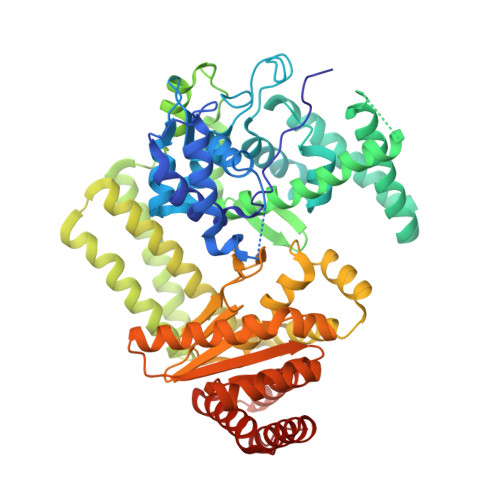Structural analysis of the heterodimeric type IIS restriction endonuclease R.BspD6I acting as a complex between a monomeric site-specific nickase and a catalytic subunit.
Kachalova, G.S., Rogulin, E.A., Yunusova, A.K., Artyukh, R.I., Perevyazova, T.A., Matvienko, N.I., Zheleznaya, L.A., Bartunik, H.D.(2008) J Mol Biology 384: 489-502
- PubMed: 18835275
- DOI: https://doi.org/10.1016/j.jmb.2008.09.033
- Primary Citation of Related Structures:
2EWF, 2P14 - PubMed Abstract:
The heterodimeric restriction endonuclease R.BspD6I from Bacillus species D6 recognizes a pseudosymmetric sequence and cuts both DNA strands outside the recognition sequence. The large subunit, Nt.BspD6I, acts as a type IIS site-specific monomeric nicking endonuclease. The isolated small subunit, ss.BspD6I, does not bind DNA and is not catalytically active. We solved the crystal structures of Nt.BspD6I and ss.BspD6I at high resolution. Nt.BspD6I consists of three domains, two of which exhibit structural similarity to the recognition and cleavage domains of FokI. ss.BspD6I has a fold similar to that of the cleavage domain of Nt.BspD6I, each containing a PD-(D/E)XK motif and a histidine as an additional putative catalytic residue. In contrast to the DNA-bound FokI structure, in which the cleavage domain is rotated away from the DNA, the crystal structure of Nt.BspD6I shows the recognition and cleavage domains in favorable orientations for interactions with DNA. Docking models of complexes of Nt.BspD6I and R.BspD6I with cognate DNA were constructed on the basis of structural similarity to individual domains of FokI, R.BpuJI and HindIII. A three-helix bundle forming an interdomain linker in Nt.BspD6I acts as a rigid spacer adjusting the orientations of the spatially separated domains to match the distance between the recognition and cleavage sites accurately.
- Max Planck Unit for Structural Molecular Biology, MPG-ASMB c/o DESY, Notkestrasse 85, 22603 Hamburg, Germany.
Organizational Affiliation:

















